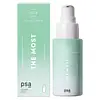What's inside
What's inside
 Key Ingredients
Key Ingredients

 Benefits
Benefits

 Concerns
Concerns

No concerns
 Ingredients Side-by-side
Ingredients Side-by-side

Water
Skin ConditioningGlycerin
HumectantCarthamus Tinctorius Seed Oil
MaskingPropanediol
SolventDimethyl Isosorbide
SolventGlucuronolactone
Skin ConditioningLeuconostoc/Radish Root Ferment Filtrate
AntimicrobialBisabolol
MaskingPolysorbate 20
EmulsifyingHyaluronic Acid
HumectantSodium Hyaluronate
HumectantSodium Hyaluronate Crosspolymer-3
HumectantSodium PCA
HumectantPanthenol
Skin ConditioningSaccharomyces/Xylinum/Black Tea Ferment
Skin ConditioningEuterpe Oleracea Fruit Extract
Madecassoside
AntioxidantGlycyrrhiza Glabra Root Extract
BleachingChondrus Crispus Extract
Skin ConditioningAllantoin
Skin ConditioningHydrolyzed Jojoba Esters
Skin ConditioningGluconolactone
Skin ConditioningSodium Lactate
BufferingSodium Gluconate
Skin ConditioningHydroxyethylcellulose
Emulsion StabilisingSodium Benzoate
MaskingSclerotium Gum
Emulsion StabilisingHydroxyethyl Acrylate/Sodium Acryloyldimethyl Taurate Copolymer
Emulsion StabilisingPotassium Sorbate
PreservativePhenoxyethanol
PreservativeWater, Glycerin, Carthamus Tinctorius Seed Oil, Propanediol, Dimethyl Isosorbide, Glucuronolactone, Leuconostoc/Radish Root Ferment Filtrate, Bisabolol, Polysorbate 20, Hyaluronic Acid, Sodium Hyaluronate, Sodium Hyaluronate Crosspolymer-3, Sodium PCA, Panthenol, Saccharomyces/Xylinum/Black Tea Ferment, Euterpe Oleracea Fruit Extract, Madecassoside, Glycyrrhiza Glabra Root Extract, Chondrus Crispus Extract, Allantoin, Hydrolyzed Jojoba Esters, Gluconolactone, Sodium Lactate, Sodium Gluconate, Hydroxyethylcellulose, Sodium Benzoate, Sclerotium Gum, Hydroxyethyl Acrylate/Sodium Acryloyldimethyl Taurate Copolymer, Potassium Sorbate, Phenoxyethanol
Aloe Barbadensis Leaf Juice
Skin ConditioningWater
Skin ConditioningOrbignya Oleifera Seed Oil
EmollientCaprylic/Capric Triglyceride
MaskingGlycerin
HumectantPropanediol
SolventTheobroma Grandiflorum Seed Butter
Skin ConditioningCetearyl Alcohol
EmollientCetyl Palmitate
EmollientSorbitan Palmitate
EmulsifyingHyaluronic Acid
HumectantOryza Sativa Extract
AbsorbentOryza Sativa Germ Extract
EmollientRose Extract
Skin ConditioningGlycine Soja Oil
EmollientPolyglyceryl-3 Diisostearate
EmulsifyingCetearyl Glucoside
EmulsifyingSodium Phytate
Xylitylglucoside
HumectantAnhydroxylitol
HumectantXylitol
HumectantSclerotium Gum
Emulsion StabilisingTocopherol
AntioxidantSorbitan Oleate
EmulsifyingBenzyl Alcohol
PerfumingSalicylic Acid
MaskingSorbic Acid
PreservativeCitric Acid
BufferingPotassium Sorbate
PreservativeAloe Barbadensis Leaf Juice, Water, Orbignya Oleifera Seed Oil, Caprylic/Capric Triglyceride, Glycerin, Propanediol, Theobroma Grandiflorum Seed Butter, Cetearyl Alcohol, Cetyl Palmitate, Sorbitan Palmitate, Hyaluronic Acid, Oryza Sativa Extract, Oryza Sativa Germ Extract, Rose Extract, Glycine Soja Oil, Polyglyceryl-3 Diisostearate, Cetearyl Glucoside, Sodium Phytate, Xylitylglucoside, Anhydroxylitol, Xylitol, Sclerotium Gum, Tocopherol, Sorbitan Oleate, Benzyl Alcohol, Salicylic Acid, Sorbic Acid, Citric Acid, Potassium Sorbate
 Reviews
Reviews

Ingredients Explained
These ingredients are found in both products.
Ingredients higher up in an ingredient list are typically present in a larger amount.
Glycerin is already naturally found in your skin. It helps moisturize and protect your skin.
A study from 2016 found glycerin to be more effective as a humectant than AHAs and hyaluronic acid.
As a humectant, it helps the skin stay hydrated by pulling moisture to your skin. The low molecular weight of glycerin allows it to pull moisture into the deeper layers of your skin.
Hydrated skin improves your skin barrier; Your skin barrier helps protect against irritants and bacteria.
Glycerin has also been found to have antimicrobial and antiviral properties. Due to these properties, glycerin is often used in wound and burn treatments.
In cosmetics, glycerin is usually derived from plants such as soybean or palm. However, it can also be sourced from animals, such as tallow or animal fat.
This ingredient is organic, colorless, odorless, and non-toxic.
Glycerin is the name for this ingredient in American English. British English uses Glycerol/Glycerine.
Learn more about GlycerinHyaluronic acid is naturally found in healthy skin. It is a humectant, meaning it draws moisture to your skin.
This ingredient helps hydrate, soothe, and protect the skin.
What makes hyaluronic acid so hydrating? It has the capacity to bind or hold large amounts of water.
Fun fact: It is already naturally found in our bodies, such as the fluids of our eyes and our joints.
Studies find this ingredient to have anti-inflammatory and anti-microbial properties. This can help speed up wound-healing.
Hyaluronic acid can be irritating if the molecule has a low-molecular weight, or if the molecules are small.
One study found low-molecular weight hyaluronic acid to be pro-inflammatory, meaning some people may experience irritation. This is because our bodies use hyaluronic acid in the wound-healing process to signal to our bodies, via irritation, that something needs healing.
The same study found high-molecular weight hyaluronic acid to be anti-inflammatory.
These are some other common types of Hyaluronic Acid:
Learn more about Hyaluronic AcidPotassium Sorbate is a preservative used to prevent yeast and mold in products. It is commonly found in both cosmetic and food products.
This ingredient comes from potassium salt derived from sorbic acid. Sorbic acid is a natural antibiotic and effective against fungus.
Both potassium sorbate and sorbic acid can be found in baked goods, cheeses, dried meats, dried fruit, ice cream, pickles, wine, yogurt, and more.
You'll often find this ingredient used with other preservatives.
Learn more about Potassium SorbatePropanediol is an all-star ingredient. It softens, hydrates, and smooths the skin.
It’s often used to:
Propanediol is not likely to cause sensitivity and considered safe to use. It is derived from corn or petroleum with a clear color and no scent.
Learn more about PropanediolSclerotium Gum is a polysaccharide gum made by the fungus, Sclerotium rolfssii. It is similar to xanthan gum.
In cosmetics, Sclerotium Gum is used to thicken the texture and to help stabilize other ingredients.
As an emulsifier, Sclerotium Gum helps prevent ingredients from separating, such as water and oil.
Learn more about Sclerotium GumWater. It's the most common cosmetic ingredient of all. You'll usually see it at the top of ingredient lists, meaning that it makes up the largest part of the product.
So why is it so popular? Water most often acts as a solvent - this means that it helps dissolve other ingredients into the formulation.
You'll also recognize water as that liquid we all need to stay alive. If you see this, drink a glass of water. Stay hydrated!
Learn more about Water